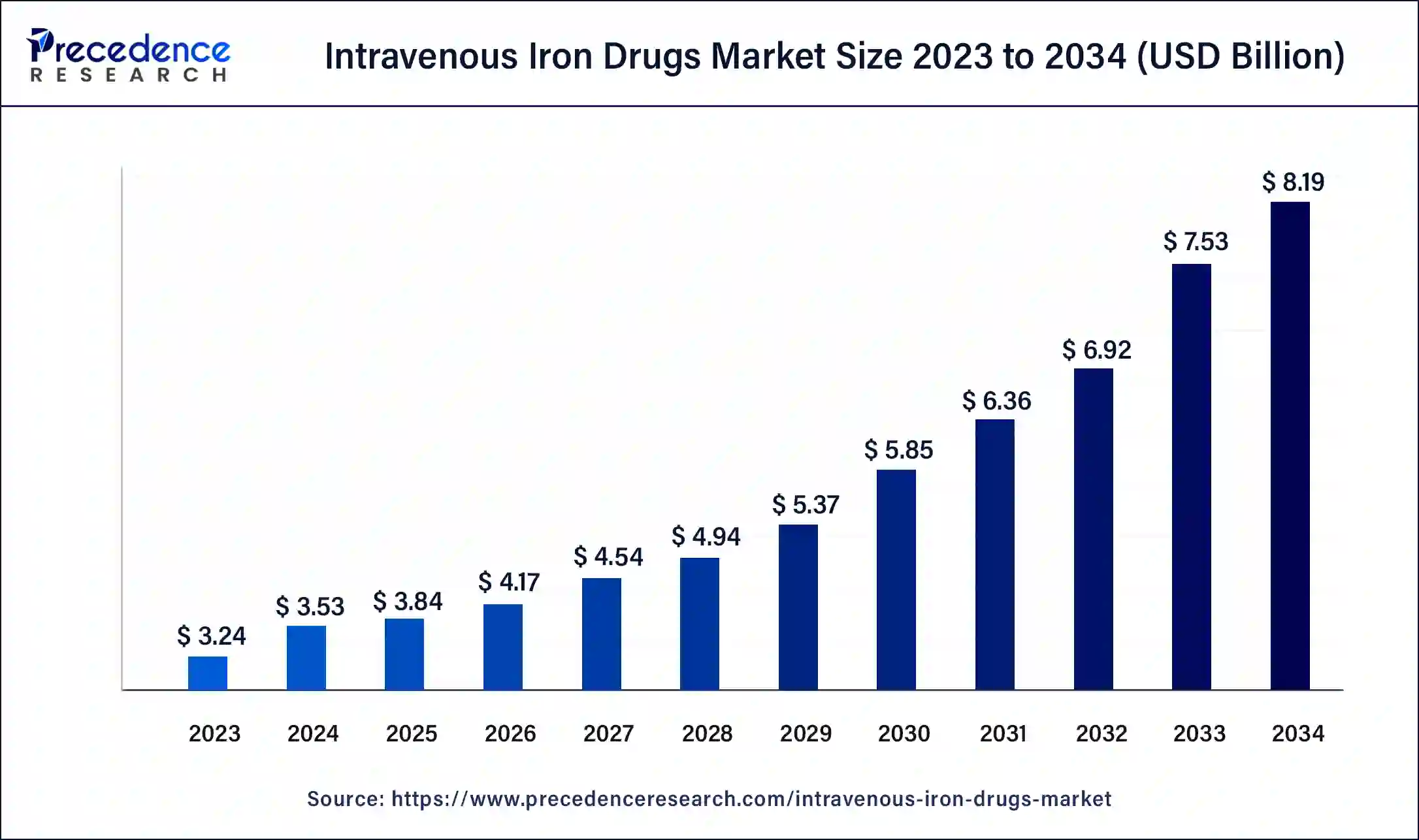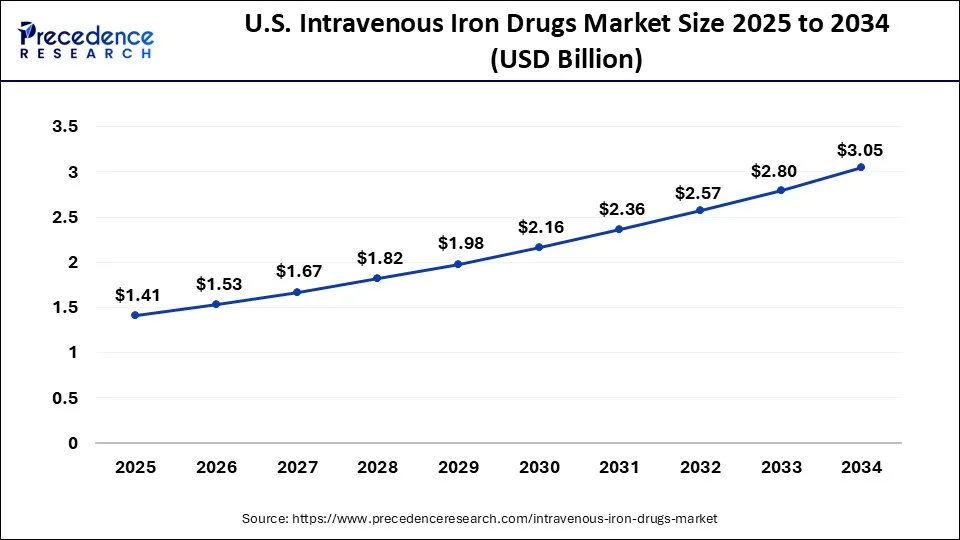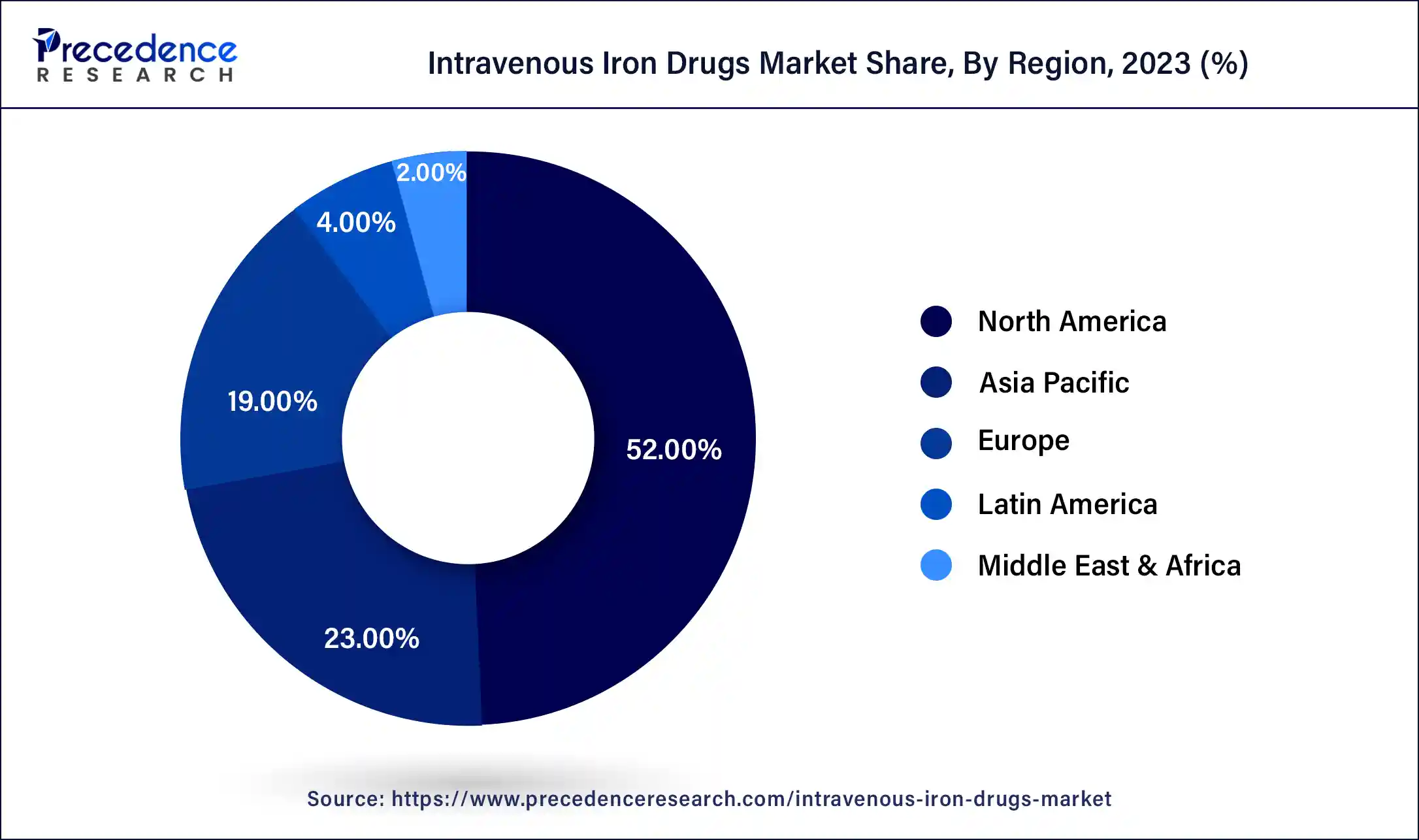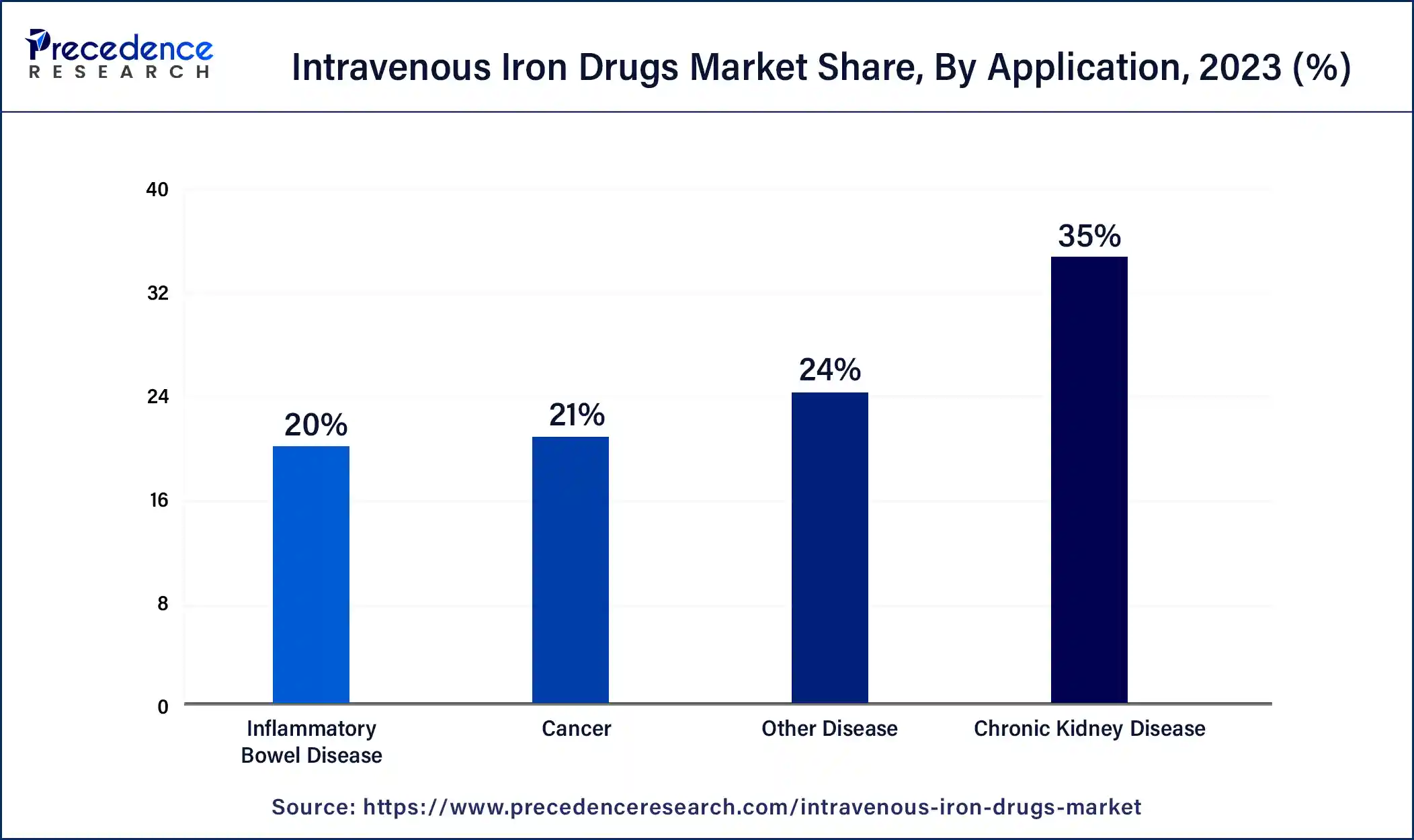List of Contents
Intravenous Iron Drugs Market Size and Forecast 2025 to 2034
The global intravenous iron drugs market size was accounted at USD 3.53 billion in 2024, and is expected to reach around USD 8.19 billion by 2034, expanding at a CAGR of 8.78% from 2025 to 2034. The North America intravenous iron drugs market size reached USD 1.84 billion in 2024. Intravenous iron medications provide a number of benefits over oral iron supplements, including quicker and more effective iron replenishment, particularly for individuals with severe iron insufficiency or malabsorption problems.

Intravenous Iron Drugs Market Key Takeaway
- The global intravenous iron drugs market was valued at USD 3.53 billion in 2024.
- It is projected to reach USD 8.19 billion by 2034.
- The intravenous iron drugs market is expected to grow at a CAGR of 8.78% from 2025 to 2034.
- North America held the largest market share of 52% in 2024.
- Asia Pacific is expected to expand at the fastest CAGR during the forecast period.
- By product, the ferric carboxymaltose segment has contributed the largest market share of 48% in 2024.
- By application, the chronic kidney disease segment dominated the market with the largest market share of 35% in 2024.
U.S. Intravenous Iron Drugs Market Size and Growth 2025 to 2034
The U.S. intravenous iron drugs market size was estimated at USD 1.29 billion in 2024 and is predicted to be worth around USD 3.05 billion by 2034, at a CAGR of 8.99% from 2025 to 2034.

North America held the largest share of the intravenous iron drugs market.A sizeable section of the population in North America suffers from iron deficiency anemia, which is a frequent ailment. This condition is more common due to factors like poor diet, gastrointestinal issues, chronic diseases, and blood loss.
Although iron deficiency anemia has historically been treated with oral iron supplements, intravenous iron therapy is gaining popularity due to its effectiveness, particularly in individuals who cannot stomach or absorb oral iron supplements well. As doctors become more knowledgeable of the advantages of intravenous iron therapy, they are providing these medications to patients with anemia due to iron deficiency more frequently.

Asia Pacific is expected to witness the fastest growth in the intravenous iron drugs market during the forecast period.Due to a number of factors, including the rising frequency of chronic diseases, including chronic kidney disease (CKD), increased awareness of iron deficiency anemia, and improved healthcare infrastructure throughout the area, the intravenous iron medication market in Asia Pacific was witnessing substantial expansion. When oral iron supplements are unsuccessful, or patients are unable to accept them, intravenous iron medications are frequently used to treat iron deficiency anemia.
The burden of anemia in nations around the Asia Pacific is being addressed by government measures, which are also propelling the expansion of the intravenous iron drugs market. The industry is also growing as a result of partnerships between pharmaceutical firms and healthcare institutions and campaigns to increase public knowledge of the value of iron supplements.
Market Overview
The intravenous iron drugs market had been rising steadily and was expected to do so at a rapid rate going forward. The aging population, an increase in the prevalence of chronic illnesses, and growing public knowledge of intravenous iron therapy were all driving factors in the market's growth. One of the main areas of focus for market participants was innovation in intravenous iron formulations.
Products with better safety profiles, fewer side effects, and more efficacy were being developed in the intravenous iron drugs market. This includes creating brand-new medication delivery methods and iron-carbohydrate complexes. Intravenous iron supplements were being utilized to treat heart failure, inflammatory bowel disease, chronic renal disease, and anemia associated with cancer, in addition to iron deficient anemia.
Regional differences were seen in the intravenous iron drugs market, with North America and Europe historically being the largest markets because of their developed healthcare systems and high levels of awareness. On the other hand, growing healthcare spending and better healthcare infrastructure were also propelling the fast expansion of emerging economies in Latin America and Asia Pacific.
For the participants of the intravenous iron drugs market, obtaining regulatory permits and adhering to strict safety regulations were essential. In order to guarantee the safety and effectiveness of intravenous iron medications, regulatory organizations like the European Medicines Agency (EMA) and the U.S. Food and Drug Administration (FDA) actively participated in the approval process.
Intravenous Iron Drugs Market Growth Factors
- A large percentage of people worldwide suffer from iron deficiency anemia, a prevalent medical ailment. The need for intravenous iron medications is being driven by the condition's increasing prevalence, thus driving the intravenous iron drugs market.
- Patients and medical professionals alike are becoming more conscious of the significance of identifying and managing iron insufficiency. The market for intravenous iron medicines has expanded as a result of this awareness campaign's enhanced diagnosis and treatment rates.
- More sophisticated and effective intravenous iron formulations have been developed as a result of ongoing research and development activities. The intravenous iron drugs market is growing because of these more recent formulations' increased efficacy, safety, and patient convenience.
- Due to factors including decreased iron absorption and chronic disorders, the aging population is more susceptible to conditions like iron deficiency anemia. Therefore, the intravenous iron drugs market is growing as a result of the growing number of older people worldwide.
- Along with increased healthcare spending, emerging economies are seeing advancements in their healthcare infrastructure. Better access to diagnosis and treatment—including intravenous iron therapy, is made possible by this, which propels intravenous iron drugs market expansion.
Market Scope
| Report Coverage | Details |
| Growth Rate from 2025 to 2034 | CAGR of 8.78% |
| Market Size in 2024 | USD 3.53 Billion |
| Market Size in 2025 | USD 3.84 Billion |
| Market Size by 2034 | USD 8.19 Billion |
| Largest Market | North America |
| Base Year | 2024 |
| Forecast Period | 2025 to 2034 |
| Segments Covered | By Product and By Application |
| Regions Covered | North America, Europe, Asia-Pacific, Latin America, and Middle East & Africa |
Market Dynamics
Driver
Growing geriatric population
Older persons frequently suffer from iron deficiency anemia as a result of a variety of conditions, including poor diet, decreased iron absorption, and chronic illnesses. Intravenous iron medications are in high demand due to the growing prevalence of this illness among the senior population. An increasing number of senior citizens are seeking treatment for ailments like iron deficiency anemia as a result of improvements in the healthcare system and increased accessibility to healthcare services.
Maintaining one's functional independence and quality of life as one age becomes more crucial. The demand for these treatments is driven by the potential benefits of treating illnesses such as anemia with intravenous iron therapy, which can enhance energy levels, cognitive function, and general well-being in older persons.
Restraint
Limited indications
Intravenous iron therapy may cause contraindications in certain patients or cause unfavorable side effects, like hypotension or allergic reactions. This may restrict certain medications' use in specific patient groups. The permitted indications for intravenous iron treatments may be limited by regulatory bodies in response to safety profiles and evidence from clinical trials. This may restrict their application to particular patient groups or medical conditions. In contrast to other disorders or patient groups, intravenous iron therapy may be more effective in treating conditions like inflammatory bowel disease or chronic renal disease. Its usage might, therefore, be restricted to these particular indications.
Opportunity
Growing prevalence of iron deficiency anemia
The intravenous iron drugs market has grown significantly in recent years due in large part to the rising prevalence of iron deficiency anemia. A disorder called iron deficiency anemia is defined by an inadequate amount of iron in the body, resulting in a deficit of healthy red blood cells. Symptoms of this illness include weakness, exhaustion, dyspnea, and compromised cognitive function.
Iron deficiency anemia can be caused by a poor dietary intake of foods high in iron, particularly in populations with limited access to nutrient-dense foods. Anemia can result from chronic inflammatory diseases that affect iron absorption and use, such as rheumatoid arthritis and chronic heart failure.
Product Insights
The ferric carboxymaltose segment held the largest share of the intravenous iron drugs market in 2024 and is expected to continue its dominance throughout the forecast period. For people with iron deficiency anemia who are intolerant to oral iron or do not respond well to oral iron, an intravenous iron formulation known as FCM is administered. It is a well-liked option among healthcare professionals due to its safety record and reputation for effectiveness.
Due to several factors, including the growing prevalence of iron deficiency anemia, growing public knowledge of the advantages of intravenous iron therapy, and improvements in drug formulation, the intravenous iron drugs market has been expanding.
The intravenous iron drugs market has been growing owing to the part to ferric carboxymaltose and other intravenous iron formulations, including iron dextran and iron sucrose. Ferric carboxymaltose is becoming more and more popular in the intravenous iron medication market due to its easy dosing schedule, lower risk of hypersensitivity reactions than some other formulations, and quick correction of iron deficient anemia.
Application Insights
The chronic kidney disease segment dominated the intravenous iron drugs market in 2024. Because intravenous iron supplements provide more iron to stimulate red blood cell synthesis, they are essential in the therapy of anemia linked to chronic kidney disease (CKD). These medications are injected straight into the circulation, avoiding the gastrointestinal tract, which is frequently damaged in those with chronic kidney disease. Worldwide, CKD is a common disorder, and one of the most common complications for CKD patients is anemia.
The need for intravenous iron medications to treat anemia in this patient population has grown as CKD prevalence has increased. The effectiveness of oral iron supplementation may be limited in people with CKD due to gastrointestinal problems such as malabsorption. Patients with CDK who may not be able to absorb oral iron supplements well are better served by intravenous iron medications since they avoid the gastrointestinal tract.

To treat anemia in individuals with chronic kidney disease, intravenous iron therapy is frequently combined with erythropoiesis-stimulating agents (ESAs). Intravenous iron supplies the required iron substrate for the production of red blood cells, which is triggered by ESAs. The demand for intravenous iron medicines is further driven by the synergy between intravenous iron and ESAs, which leads to their combination usage in patients with chronic kidney disease.
Intravenous iron therapy is a commonly recommended therapeutic option for anemia in patients with chronic kidney disease according to clinical standards and recommendations. The treatment of CKD-related anemia continues to depend on intravenous iron supplements as long as medical professionals adhere to these recommendations.
Intravenous Iron Drugs Market Companies
- Allergan Plc.
- AMAG Pharmaceuticals, Inc.
- Daiichi Sankyo, Inc.
- Luitpold Pharmaceuticals, Inc.
- American Regent, Inc.
- Pharmacosmos A/S
- Sanofi US
- Vifor Pharma Ltd.
Recent Developments
- In May 2023,the goal of Orofer FCM 750, a new parenteral iron brand extension from Emcure Pharmaceuticals Limited (EPL) that contains ferric carboxymaltose (FCM), is to give patients with iron deficiency and iron deficiency anemia (IDA) an efficient and simple option. This establishes Emcure India as the pioneer business in the introduction of the injectable 750 mg version of ferric carboxymaltose.
Segment Covered in the Report
By Product
- Iron Sucrose
- Iron Dextran
- Ferric Carboxymaltose
By Application
- Chronic Kidney Disease
- Inflammatory Bowel Disease
- Cancer
- Other Disease
By Geography
- North America
- Europe
- Asia-Pacific
- Latin America
- Middle East and Africa
For inquiries regarding discounts, bulk purchases, or customization requests, please contact us at sales@precedenceresearch.com
Frequently Asked Questions
Ask For Sample
No cookie-cutter, only authentic analysis – take the 1st step to become a Precedence Research client